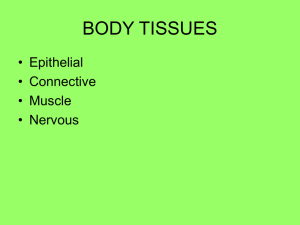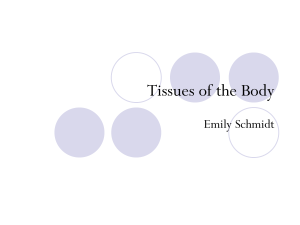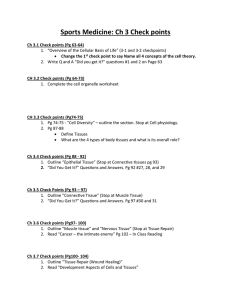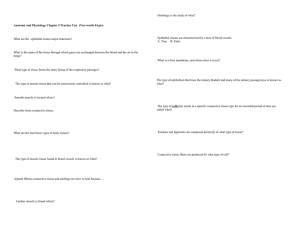Copy into Note Packet and Return to Teacher Cells and Tissues
advertisement
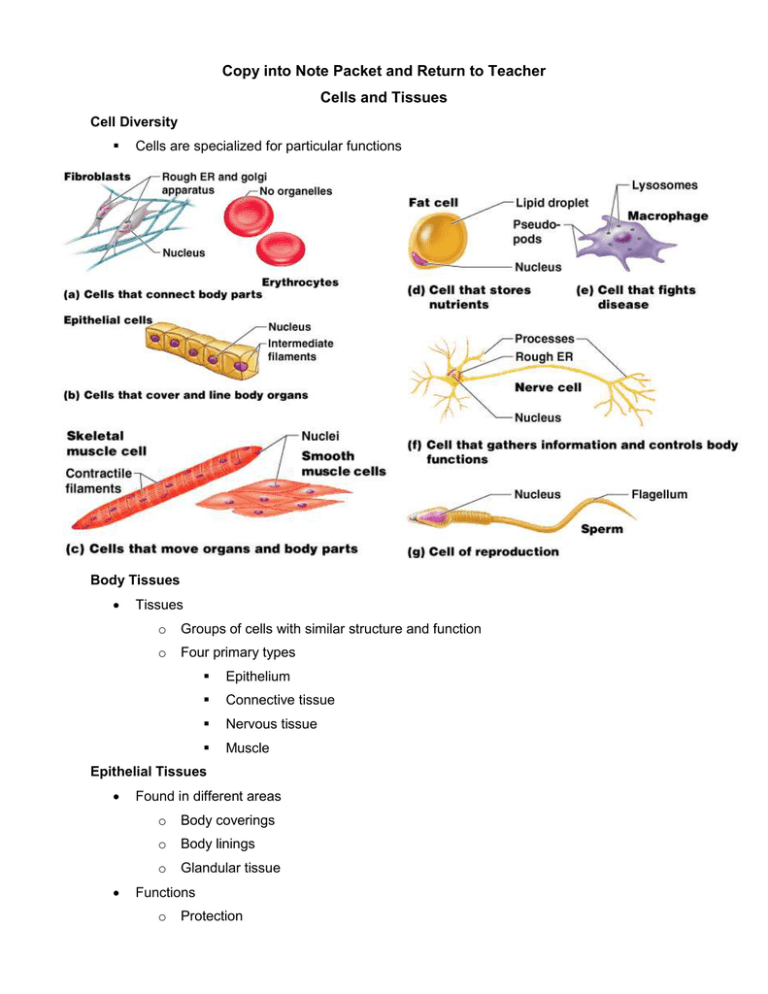
Copy into Note Packet and Return to Teacher Cells and Tissues Cell Diversity Cells are specialized for particular functions Body Tissues Tissues o Groups of cells with similar structure and function o Four primary types Epithelium Connective tissue Nervous tissue Muscle Epithelial Tissues Found in different areas o Body coverings o Body linings o Glandular tissue Functions o Protection o Absorption o Filtration o Secretion Epithelium Characteristics Cells fit closely together Tissue layer always has one free surface The lower surface is bound by a basement membrane Avascular (have no blood supply) Regenerate easily if well nourished Classification of Epithelium Number of cell layers o Simple – one layer o Stratified – more than one layer Shape of cells o Squamous – flattened o Cuboidal – cube-shaped o Columnar – column-like Simple Epithelium Simple squamous o Single layer of flat cells o Usually forms membranes Lines body cavities Lines lungs and capillaries Simple cuboidal o Single layer of cube-like cells o Common in glands and their ducts o Forms walls of kidney tubules o Covers the ovaries Simple columnar o Single layer of tall cells o Often includes goblet cells, which produce mucus o Lines digestive tract Pseudostratified o Single layer, but some cells are shorter than others o Often looks like a double cell layer o Sometimes ciliated, such as in the respiratory tract o May function in absorption or secretion Stratified Epithelium Stratified squamous o Cells at the free edge are flattened o Found as a protective covering where friction is common o Locations Mouth Esophagus Two layers of cuboidal cells Stratified columnar o Skin Stratified cuboidal o Surface cells are columnar, cells underneath vary in size and shape Stratified cuboidal and columnar o Rare in human body o Found mainly in ducts of large glands Transitional epithelium o Shape of cells depends upon the amount of stretching o Lines organs of the urinary system Glandular Epithelium Gland – one or more cells that secretes a particular product Two major gland types o o Endocrine gland Ductless Secretions are hormones Exocrine gland Empty through ducts to the epithelial surface Include sweat and oil glands Connective Tissue Found everywhere in the body Includes the most abundant and widely distributed tissues Functions o Binds body tissues together o Supports the body o Provides protection Connective Tissue Characteristics Variations in blood supply o Some tissue types are well vascularized o Some have poor blood supply or are avascular Extracellular matrix o Non-living material that surrounds living cells Extracellular Matrix Two main elements o Ground substance – mostly water along with adhesion proteins and polysaccharide molecules o Fibers Produced by the cells Three types Collagen fibers Elastic fibers Reticular fibers Connective Tissue Types Bone (osseous tissue) o Composed of: Bone cells in lacunae (cavities) Hard matrix of calcium salts Large numbers of collagen fibers o Hyaline cartilage o Most common cartilage o Composed of: o Used to protect and support the body Abundant collagen fibers Rubbery matrix Entire fetal skeleton is hyaline cartilage Elastic cartilage o Provides elasticity o Example: supports the external ear Fibrocartilage o Highly compressible o Example: forms cushion-like discs between vertebrae Dense connective tissue o Main matrix element is collagen fibers o Cells are fibroblasts o Examples Tendon – attach muscle to bone Ligaments – attach bone to bone Areolar connective tissue o Most widely distributed connective tissue o Soft, pliable tissue o Contains all fiber types o Can soak up excess fluid Adipose tissue o Matrix is an areolar tissue in which fat globules predominate o Many cells contain large lipid deposits o Functions Insulates the body Protects some organs Serves as a site of fuel storage Reticular connective tissue o Delicate network of interwoven fibers o Forms stroma (internal supporting network) of lymphoid organs Lymph nodes Spleen Bone marrow Blood o Blood cells surrounded by fluid matrix o Fibers are visible during clotting o Functions as the transport vehicle for materials Muscle Tissue Function is to produce movement Three types o Skeletal muscle o Cardiac muscle o Smooth muscle Muscle Tissue Types Skeletal muscle o Can be controlled voluntarily o Cells attach to connective tissue o Cells are striated o Cells have more than one nucleus Cardiac muscle o Found only in the heart o Function is to pump blood (involuntary) o Cells attached to other cardiac muscle cells at intercalated disks o Cells are striated o One nucleus per cell Smooth muscle o Involuntary muscle o Surrounds hollow organs o Attached to other smooth muscle cells o No visible striations o One nucleus per cell Nervous Tissue Neurons and nerve support cells Function is to send impulses to other areas of the body o Irritability o Conductivity Plasma Membrane Specializations Microvilli o Finger-like projections that increase surface area for absorption Membrane junctions o Tight junctions o Desmosomes o Gap junctions Tissue Repair Regeneration o Fibrosis o Replacement of destroyed tissue by the same kind of cells Repair by dense fibrous connective tissue (scar tissue) Determination of method o Type of tissue damaged o Severity of the injury Events in Tissue Repair Capillaries become very permeable o Introduce clotting proteins o Wall off injured area Formation of granulation tissue Regeneration of surface epithelium Regeneration of Tissues Tissues that regenerate easily o Epithelial tissue o Fibrous connective tissue and bone Tissues that regenerate poorly o Skeletal muscle Tissues that are replaced largely with scar tissue o Cardiac muscle o Nervous tissue within the brain and spinal cord Developmental Aspects of Tissue Epithelial tissue arises from all three primary germ layers Muscle and connective tissue arise from the mesoderm Nervous tissue arises from the ectoderm With old age there is a decrease in mass and viabililty in most tissues




